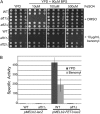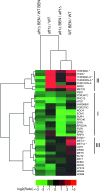Functional genomics analysis of the Saccharomyces cerevisiae iron responsive transcription factor Aft1 reveals iron-independent functions
- PMID: 20439772
- PMCID: PMC2900968
- DOI: 10.1534/genetics.110.117531
Functional genomics analysis of the Saccharomyces cerevisiae iron responsive transcription factor Aft1 reveals iron-independent functions
Abstract
The Saccharomyces cerevisiae transcription factor Aft1 is activated in iron-deficient cells to induce the expression of iron regulon genes, which coordinate the increase of iron uptake and remodel cellular metabolism to survive low-iron conditions. In addition, Aft1 has been implicated in numerous cellular processes including cell-cycle progression and chromosome stability; however, it is unclear if all cellular effects of Aft1 are mediated through iron homeostasis. To further investigate the cellular processes affected by Aft1, we identified >70 deletion mutants that are sensitive to perturbations in AFT1 levels using genome-wide synthetic lethal and synthetic dosage lethal screens. Our genetic network reveals that Aft1 affects a diverse range of cellular processes, including the RIM101 pH pathway, cell-wall stability, DNA damage, protein transport, chromosome stability, and mitochondrial function. Surprisingly, only a subset of mutants identified are sensitive to extracellular iron fluctuations or display genetic interactions with mutants of iron regulon genes AFT2 or FET3. We demonstrate that Aft1 works in parallel with the RIM101 pH pathway and the role of Aft1 in DNA damage repair is mediated by iron. In contrast, through both directed studies and microarray transcriptional profiling, we show that the role of Aft1 in chromosome maintenance and benomyl resistance is independent of its iron regulatory role, potentially through a nontranscriptional mechanism.
Figures






Similar articles
-
Direct activation of genes involved in intracellular iron use by the yeast iron-responsive transcription factor Aft2 without its paralog Aft1.Mol Cell Biol. 2005 Aug;25(15):6760-71. doi: 10.1128/MCB.25.15.6760-6771.2005. Mol Cell Biol. 2005. PMID: 16024809 Free PMC article.
-
Activation of the iron regulon by the yeast Aft1/Aft2 transcription factors depends on mitochondrial but not cytosolic iron-sulfur protein biogenesis.J Biol Chem. 2005 Mar 18;280(11):10135-40. doi: 10.1074/jbc.M413731200. Epub 2005 Jan 13. J Biol Chem. 2005. PMID: 15649888
-
Cisplatin upregulates Saccharomyces cerevisiae genes involved in iron homeostasis through activation of the iron insufficiency-responsive transcription factor Aft1.J Cell Physiol. 2007 Feb;210(2):378-84. doi: 10.1002/jcp.20845. J Cell Physiol. 2007. PMID: 17096368
-
Mechanisms of iron sensing and regulation in the yeast Saccharomyces cerevisiae.World J Microbiol Biotechnol. 2017 Apr;33(4):75. doi: 10.1007/s11274-017-2215-8. Epub 2017 Mar 17. World J Microbiol Biotechnol. 2017. PMID: 28315258 Review.
-
Iron sensing and regulation in Saccharomyces cerevisiae: Ironing out the mechanistic details.Curr Opin Microbiol. 2013 Dec;16(6):662-8. doi: 10.1016/j.mib.2013.07.020. Epub 2013 Aug 17. Curr Opin Microbiol. 2013. PMID: 23962819 Free PMC article. Review.
Cited by
-
The yeast Aft2 transcription factor determines selenite toxicity by controlling the low affinity phosphate transport system.Sci Rep. 2016 Sep 13;6:32836. doi: 10.1038/srep32836. Sci Rep. 2016. PMID: 27618952 Free PMC article.
-
Synthetic circuit identifies subpopulations with sustained memory of DNA damage.Genes Dev. 2011 Mar 1;25(5):434-9. doi: 10.1101/gad.1994911. Genes Dev. 2011. PMID: 21363961 Free PMC article.
-
Yeast glutaredoxin, GRX4, functions as a glutathione S-transferase required for red ade pigment formation in Saccharomyces cerevisiae.J Biosci. 2020;45:39. J Biosci. 2020. PMID: 32098918
-
Phenotypic heterogeneity follows a growth-viability tradeoff in response to amino acid identity.Nat Commun. 2024 Aug 2;15(1):6515. doi: 10.1038/s41467-024-50602-8. Nat Commun. 2024. PMID: 39095345 Free PMC article.
-
Transcriptome profiling of transcription factors in Ganoderma lucidum in response to methyl jasmonate.Front Microbiol. 2022 Nov 24;13:1052377. doi: 10.3389/fmicb.2022.1052377. eCollection 2022. Front Microbiol. 2022. PMID: 36504766 Free PMC article.
References
-
- Abelson, J. N., M.I. Simon, C. Guthrie and G.R. Fink, 2004. Guide to Yeast Genetics and Molecular Biology. Elsevier Academic Press, San Diego, CA.
-
- Baetz, K., V. Measday and B. Andrews, 2006. Revealing hidden relationships among yeast genes involved in chromosome segregation using systematic synthetic lethal and synthetic dosage lethal screens. Cell Cycle 5 592–595. - PubMed
-
- Bennett, C. B., L. K. Lewis, G. Karthikeyan, K. S. Lobachev, Y. H. Jin et al., 2001. Genes required for ionizing radiation resistance in yeast. Nat. Genet. 29 426–434. - PubMed
Publication types
MeSH terms
Substances
Associated data
- Actions
LinkOut - more resources
Full Text Sources
Other Literature Sources
Medical
Molecular Biology Databases

